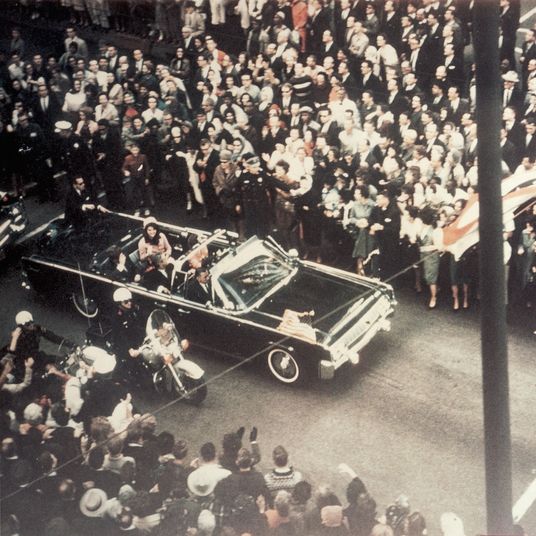
What’s really misleading about extremely close election contests is that if you stare at the poll numbers long and hard enough, small trends and distinctions grow in stature and meaning and overtake the more fundamental reality that errors are likely and we really don’t know what’s going to happen. That’s where we are in polls about the Kamala Harris–Donald Trump contest with a week-and-a-half left until Election Day.
For the first time in this cycle, really, we are seeing divergences in the polling averages based on how and whether those administering it adjust for the mix of pollsters releasing public data. RealClearPolitics, which accepts virtually all polling data as equally legitimate and conducts a simple arithmetical average, shows Kamala Harris’s longstanding national lead now vanishing, with the two candidates tied at 48 percent. With the same available data, FiveThirtyEight, which weighs polls for quality and partisan bias, shows Harris leading nationally by 1.7 percent (48.2 to 46.4 percent). Nate Silver, with his own weighting system, has Harris up by 1.3 percent nationally, though in an interesting wrinkle, he actually projects her winning the national popular vote by 1.9 percent (based on extrapolation from state polls). The Washington Post, which also adjusts polls but rounds the numbers, has Harris leading by two points. But with these relatively small variations in the national vote, the four sources of polling averages show big variation in the Electoral College outcome. RCP has Trump leading in all seven battleground states and harvesting 312 electoral votes. FiveThirtyEight has Trump leading in four battleground states (Arizona by 1.8 percent; Georgia by 1.5 percent; North Carolina by 1.2 percent; and Pennsylvania by 0.3 percent), and Harris leading in three (Michigan by 0.6 percent, Nevada by 0.1 percent, and Wisconsin by 0.2 percent), which would translate to 281 electoral votes for Trump. Silver has the same battleground-state results with slightly different averages. And the Washington Post shows Harris leading in four battleground states (Michigan, Nevada, Pennsylvania, and Wisconsin), which would give her 276 electoral votes.
But you can find credible polls diverging from the averages in all seven states. Three recent Arizona polls (Marist, Bloomberg–Morning Consult, and AtlasIntel) have Harris and Trump tied there. Marist and TIPP–American Greatness have the two candidates tied in Georgia as well. SurveyUSA and AtlasIntel show Harris up by a point in North Carolina. In Pennsylvania, Harris leads by two points, per Bloomberg–Morning Consult, or by four points, per Franklin and Marshall (at least among registered voters; Trump leads by one among likely voters). Meanwhile, Trump is up in Michigan by two points if you believe Trafalgar, and by three points according to AtlasIntel. In Nevada, Trump’s up a point, per Redfield and Wilton. Finally, in Wisconsin, Trump leads by a point, according to Emerson.
Election forecasts are all very close, with Trump leading slightly. FiveThirtyEight and Decision Desk HQ give Trump a 52 percent chance of winning; the Economist gives him a 53 percent chance, and Nate Silver raises that to 54 percent. These are probabilities, to be clear, not projected margins of victory; it means that in massive numbers of simulations of the results, Trump wins slightly more often than Harris. The reality is that the winner and loser will be determined by the direction of polling error in each battleground state, and we have no way of knowing whether such errors will favor Harris or Trump. In the final New York Times-Siena poll, for example, the two candidates are tied among likely voters. But there are indications Harris is over-performing among white voters and under-performing among Black and Latino voters, which might indicate she could win the “Blue Wall” states of Michigan, Pennsylvania, and Wisconsin even if she doesn’t do as well in uncontested blue and red states with larger minority populations. More generally, the winner will be the candidate with the most effective voters-mobilization strategy (with Trump relying on an unusual and outsourced effort to reach low-propensity voters and Harris conducting a more traditional get-out-the-vote operation) and closing argument (with both candidates getting more personal, but with Trump counting heavily on anti-transgender ads and Harris stressing the former president’s dangerous unreliability and narcissism).
There’s time enough for a last-minute shift in the polls, but right now if anyone uses polls to predict the winner, the proper question should be this: “Which ones?” The averages continue to make it too close to call.
This post has been updated.
More on politics
- Trump Doesn’t Just Like Putin — He’s Like Putin
- Trump to Personally Investigate ‘Stolen’ Fort Knox Gold Theory
- HUD TVs Hacked to Play Video of Trump Kissing Musk’s Feet






























